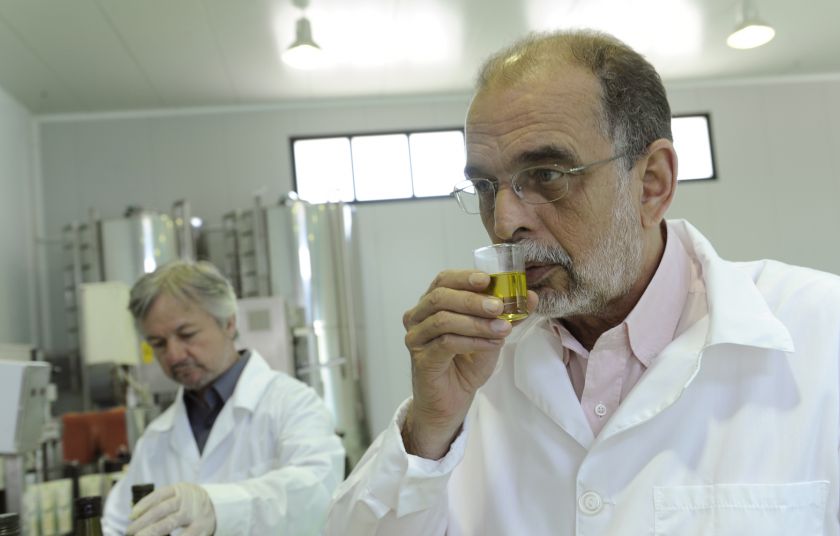Vasileios (Vassilis) ZAMPOUNIS studied Agricultural Economy at the University of Athens, Greece and Reading, UK. He has been working professionally in the olive sector since 1980. He began at Elaiourgiki (the national organisation of cooperatives of olive producers), as Head of the E.U. office. In 1992 he resigned and founded Axion Ekdotiki (a publishing company) and later on Axion Agrotiki Ltd (consulting company) acting as CEO since 2016. Axion Agrotiki Ltd, focused on the submission and management of European community projects. He published the “Coding of the Legislation for the olive sector” (1992-1997) and the hard copy bimonthly magazine “Olive & Olive oil”, 1997 – today), and the olivenews.gr news website. He was engaged either as an author or a contributor in many publications, studies as well as a speaker in numerous events and conferences in Greece and abroad on topics related to olive sector. Principal organizer of international conferences on olive oil quality (2001 and 2011). He initiated and supported the founding of several partnerships and collaborations such as Olive Products of Certified Quality (El3p) and Scientific Society of Olive Encyclopedists (4E).
What are the main agronomic characteristics of the Koroneiki variety?
Koroneiki takes its name from the town Koroni in Messinia because the port of Koroni has exported this type of olive oil since ancient times. Literally the name means crown. You can also find it with the names Vatsiki, Koronia, Ladolia, Lianolia, Psilolia. All names that they reveal something about the agronomic information. For example, Ladolia means that it gives a lot of olive oil . Or Psilolia means that it has small fruits.
It has the advantage of adapting to adverse conditions, extremely dry and withstand strong winds. It can be cultivated from coastal areas, up to a height of 500 meters. It grows on a tree 5 to 7 meters high. Its leaves are deep green, 5.47cm long and 1.03cm wide. The fruit is cylindrical in shape with an average weight of 1.3 g. The flesh-to-core ratio is 6.6: 1. The oil content of the fruit ranges from 15% to 27%. It is used exclusively for the production of high quality oil. The yield of the fruit variety per tree is 30 – 100 kg. It is considered a very productive and resistant variety in the arid regions of the country. Has low requirements in cultivation. It is resistant to cyclones, moderately resistant to verticillium and susceptible to cancer. Finally, it is susceptible to dragonfly, olive and carp. The fruit ripens from early October to December.
In your experience, what is the difference with the other varieties that you know?
You mean with other greek varieties ?
For example I live in the area of Messinia, Greece. Here we cultivate KALAMON – The Kalamon tree is bigger and the leaves are as well. The fruits are bigger than Koroneiki, but they don’t produce a lot of olive oil. I think it is at 8%. It is a variety of high productivity midriff, demanding in soil and atmospheric humidity, resistant to soil salinity, and resistant to fungal vertigo. The weight of the fruit varies from 5 to 6 gr in the shape of a cylindrical one-sided bending .The skin of the wrist is delicate and elastic and acquires a deep black color at the stage of full maturity, while its core is smooth and easily detached from the flesh. This makes it the ideal variety for the production of natural black edible olives. The Kalam tree is quite sturdy, its branches have vertical growth and characteristically large leaves. Harvesting is done by hand at full maturity during November – December
Also we have CHORAITIKI, this variety is ready at the first ten days of October and gives olive oil with a very delicate aroma. What always impresses me to the olive oil from Koroneiki apart from the delicate/medium organoleptic profile is the fact that keeps its characteristics until the expiry date ( of course when it is kept under the right conditions. )
Does the Koronei variety need a different management compared to other olives in the Mediterranean region?
I think that it has important steps such as pruning. Pruning is the basic stage that shapes the branches and allows the air and sun to reach the fruit. Pruning an olive tree is a real art. The farmer must carefully prune each tree individually as needed, maintaining the overall, long-term plan that testifies to the shape and productive history of each tree. The next important step is to fertilize, when necessary, to ensure that the right soil nutrients are maintained from season to season. Usually the only nutrients a tree needs are leaves and branches that have fallen naturally over time. As they are incorporated into the soil, they are regenerated as food for the olive tree. The grass under the tree should also be cut and weeds removed ( by cutting ) to make it easier to absorb water and nutrients and also to prevent crop failure.
How do you evaluate the EVOO produced by Koroneiki?
In 2018 and in 2019 my brand was given an award as the BEST MONOVARIETAL olive oil from the two most important companions in the world that is EVO IOOC, directed from Antonio Lauro and FLOS OLEI. Koroneiki is characterised by a robust olive fruity intensity reminiscent of the typical odour of fruit before it ripens. Fresh banana, tomato leaf and flowers with a distinct suggestion of almond and apple. Its taste shows a good fresh vibrant palate with a delicate taste of pungent and bitter notes of arugula and radish.
Brazilians like foods with pungent ingredients. In the conditions of Brazil, this variety produces EVOO mainly with this attribute. Do you think that one olive oil with this sensory characteristic can help increase the consumption of EVOO in this country?
From what I have learned from my experience the last 9 years is that people-consumers love Koroneiki. Because it has a complex fruitiness and a balance between bitter and spicy. Every year I give more than 100 olive oil tasting in the luxury hotels of messinia. In my tastings all people love koroneiki. Then Koroneiki, exactly because it has a balance, makes amazing tasty and easy food pairings without “killing” the taste of food. I am strongly convinced that is the type of EVOO that can help the increase of the EVOO consumption not only in Brazil, but also in the rest of the world.
Based on your experience and knowledge, what is the characteristic of EVOO produced by this variety that has led to it being so accepted in a country outside the Mediterranean area and with such different culinary habits?
As I said above. Its balance, its complex fruitiness, the low acidity , its high levels of polyphenols, the fact that lasts in time. Maybe the olive oil tasters that usually get their education in Tuscany are biased and they always tend to over-reward the olive oil from Tuscany. Personally, I love Koroneiki because it’s excellent without a blend. Outside the Mediterranean area it’s easily accepted because, for example, Northern Europe is used to eating butter, so a very sweet taste for this reason they love the balance of Koroneiki. And most importantly, the easy food pairings that it makes. It’s super for fish, without destroying the taste of fish, etc.

